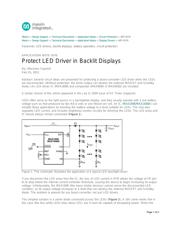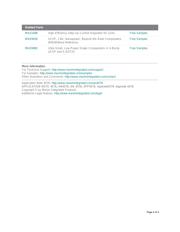herunterladen

Maxim > Design Support > Technical Documents > Application Notes > Circuit Protection > APP 4576
Maxim > Design Support > Technical Documents > Application Notes > Display Drivers > APP 4576
Keywords: LED drivers, backlit displays, battery operation, circuit protection
APPLICATION NOTE 4576
Protect LED Driver in Backlit Displays
By: Massimo Caprioli
Feb 01, 2011
Abstract: Several circuit ideas are presented for protecting a boost-converter LED driver when the LEDs
are disconnected. (Without protection, the driver output can destroy the external MOSFET and Schottky
diode.) An LED-driver IC (MAX1698) and comparator (MAX9060 or MAX9028) are included.
A similar version of this article appeared in the July 6, 2009 issue of EE Times magazine.
LEDs often serve as the light source in a backlighted display, and they usually operate with a low battery
voltage such as that produced by two NiCd cells or one lithium-ion cell. An IC (MAX1698/MAX1698A) can
simplify these applications by boosting the battery voltage to a level suitable for LEDs. The chip also
regulates LED current, and includes brightness-control circuitry for dimming the LEDs. The LED array and
IC should always remain connected (Figure 1).
Figure 1. This schematic illustrates the application of a typical LED-backlight driver.
If you disconnect the LED array from the IC, the loss of LED current in RFB allows the voltage at FB (pin
6) to drop below the internal current-controller threshold, causing the device to begin increasing its output
voltage. Unfortunately, the MAX1698 (like many similar devices) cannot sense the disconnected-LED
condition, so its output voltage increases to a level that can destroy the external MOSFET and Schottky
diode. This problem is present for any boost converter; not just LED drivers.
The simplest solution is a zener diode connected across the LEDs (Figure 2). A 16V zener works fine in
this case (the four white LEDs drop about 12V), but it must be capable of dissipating power. When the
Page 1 of 4






